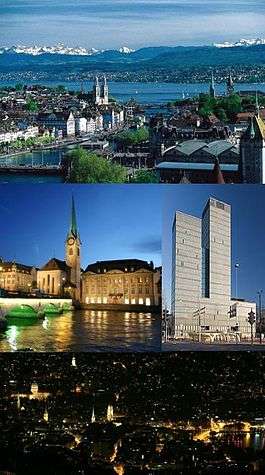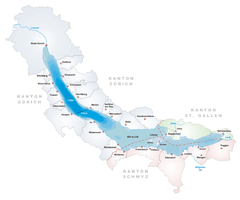Zürich
| Zürich | ||
|---|---|---|
|
Top: View over Zürich and the lake Middle: Fraumünster Church on the river Limmat (left) and the Sunrise Tower (right) Bottom: Night view of Zürich from Üetliberg | ||
| ||
 Zürich | ||
|
Location of Zürich  | ||
| Coordinates: 47°22′N 8°33′E / 47.367°N 8.550°ECoordinates: 47°22′N 8°33′E / 47.367°N 8.550°E | ||
| Country | Switzerland | |
| Canton | Zürich | |
| District | Zürich | |
| Government | ||
| • Executive |
Stadtrat with 9 members | |
| • Mayor |
Stadtpräsidentin (list) Corine Mauch SPS/PSS (as of February 2014) | |
| • Parliament |
Gemeinderat with 125 members | |
| Area[1] | ||
| • Total | 87.88 km2 (33.93 sq mi) | |
| Elevation | 408 m (1,339 ft) | |
| Highest elevation (Üetliberg) | 871 m (2,858 ft) | |
| Lowest elevation (Limmat) | 392 m (1,286 ft) | |
| Population (Dec 2015[2]) | ||
| • Total | 396,027 | |
| • Density | 4,500/km2 (12,000/sq mi) | |
| Demonym(s) | German: Zürcher(in) | |
| Postal code | 8000–8099 | |
| SFOS number | 0261 | |
| Surrounded by | Adliswil, Dübendorf, Fällanden, Kilchberg, Maur, Oberengstringen, Opfikon, Regensdorf, Rümlang, Schlieren, Stallikon, Uitikon, Urdorf, Wallisellen, Zollikon | |
| Twin towns | Kunming, San Francisco | |
| Website |
www SFSO statistics | |
Zürich or Zurich (/ˈzjʊərɪk/, Swiss Standard German: Zürich [ˈtsʏrɪç], German Standard German Zürich [ˈtsyːʁɪç], Swiss German: Züri [ˈtsyɾi], French: Zurich [zyʁik], Italian: Zurigo [dzuˈriːɡo], Romansh: Turitg [tuˈritɕ]) is the largest city in Switzerland and the capital of the canton of Zürich. It is located in north-central Switzerland[3] at the northwestern tip of Lake Zürich. The municipality has approximately 400,028[4] inhabitants, the urban agglomeration 1.315 million,[5] and the Zurich metropolitan area 1.83 million.[6] Zürich is a hub for railways, roads, and air traffic. Both Zürich Airport and railway station are the largest and busiest in the country.
Permanently settled for around 2000 years, Zürich has a history that goes back to its founding by the Romans, who, in 15 BC, called it Turicum. However, early settlements have been found dating back more than 6400 years ago.[7] During the Middle Ages, Zürich gained the independent and privileged status of imperial immediacy and, in 1519, became a primary centre of the Protestant Reformation in Europe under the leadership of Ulrich Zwingli.[8]
The official language of Zürich is (the Swiss variety of Standard) German, but the main spoken language is the local variant of the Alemannic Swiss German dialect.
Zürich is a leading global city and among the world's largest financial centres despite having a relatively low population.[9] The city is home to a large number of financial institutions and banking giants. Most of Switzerland's research and development centres are concentrated in Zürich and the low tax rates attract overseas companies to set up their headquarters there.
Monocle's 2012 "Quality of Life Survey" ranked Zürich first on a list of the top 25 cities in the world "to make a base within".[10]
According to several surveys from 2006 to 2008, Zürich was named the city with the best quality of life in the world as well as the wealthiest city in Europe.[11][12][13] The Economist Intelligence Unit's Global Liveability Ranking[14] sees Zürich rank among the top ten most liveable cities in the world.
Many museums and art galleries can be found in the city, including the Swiss National Museum and the Kunsthaus.[15] Schauspielhaus Zürich is one of the most important theatres in the German-speaking world.[16]
Name
The Swiss standard German pronunciation of the name is [ˈtsyːrɪx]. In Zürich German the name is pronounced without the final consonant, Züri [ˈtsyɾi], although the adjective remains Zürcher [ˈtsyrxər]. The city is called Zurich [zyʁik] in French, Zurigo [dzuˈriːɡo] in Italian,[17] and Turitg [tuˈritɕ] in Romansh.
In English, the name is usually written Zurich, without the umlaut. It is pronounced /ˈzjʊərɪk/ (ZEWR-ik) or /ˈzʊərɪk/ (ZOOR-ik); more recently sometimes also with /ts/ as in German.[18]
The earliest known form of the city's name is Turicum, attested on a tombstone of the late 2nd century AD in the form STA(tio) TURICEN(sis) ("Turicum tax post"). Neither the name's linguistic origin (most likely Rhaetic or Celtic) nor its meaning can be determined with certainty. A possibility is derivation from *Turīcon, from the Gaulish personal name Tūros.[19] The Latin stress on the long vowel of the Gaulish name, [tuˈriːkon], was lost in German [ˈtsyːʁɪç] but is preserved in Italian Zurigo [dzuˈriːɡo] and in Romansh Turitg [tuˈritɕ].
A first development towards its later, Germanic form is attested as early as the 6th century with the form Ziurichi. From the 10th century onward, the name has more or less clearly been established as Zürich (Zurih (857), Zürich (924)).[20]
Zürich is sometimes referred to as "Downtown Switzerland" for publicity reasons.[21]
History
Early history
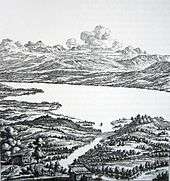
Settlements of the Neolithic and Bronze Age were found around Lake Zürich. Traces of pre-Roman Celtic, La Tène settlements were discovered near the Lindenhof hill. In Roman times, Turicum was a tax-collecting point at the border of Gallia Belgica (from AD 90 Germania Superior) and Raetia for goods trafficked on the river Limmat. After Emperor Constantine's reforms in AD 318, the border between Gaul and Italy (two of the four praetorian prefectures of the Roman Empire) was located east of Turicum, crossing the river Linth between Lake Walen and Lake Zürich, where a castle and garrison looked over Turicum's safety. The earliest written record of the town dates from the 2nd century, with a tombstone referring to it as to the Statio Turicensis Quadragesima Galliarum ("Zürich post for collecting the 2.5% value tax of the Galliae"), discovered at the Lindenhof.[22]
In the 5th century, the Germanic Alemanni tribe settled in the Swiss Plateau. The Roman castle remained standing until the 7th century. A Carolingian castle, built on the site of the Roman castle by the grandson of Charlemagne, Louis the German, is mentioned in 835 (in castro Turicino iuxta fluvium Lindemaci). Louis also founded the Fraumünster abbey in 853 for his daughter Hildegard. He endowed the Benedictine convent with the lands of Zürich, Uri, and the Albis forest, and granted the convent immunity, placing it under his direct authority. In 1045, King Henry III granted the convent the right to hold markets, collect tolls, and mint coins, and thus effectively made the abbess the ruler of the city.[23]
Zürich gained Imperial immediacy (Reichsunmittelbar, becoming an Imperial free city) in 1218 with the extinction of the main line of the Zähringer family and attained a status comparable to statehood. During the 1230s, a city wall was built, enclosing 38 hectares, when the earliest stone houses on the Rennweg were built as well. The Carolingian castle was used as a quarry, as it had started to fall into ruin.[24]
Emperor Frederick II promoted the abbess of the Fraumünster to the rank of a duchess in 1234. The abbess nominated the mayor, and she frequently delegated the minting of coins to citizens of the city. The political power of the convent slowly waned in the 14th century, beginning with the establishment of the Zunftordnung (guild laws) in 1336 by Rudolf Brun, who also became the first independent mayor, i.e. not nominated by the abbess.
An important event in the early 14th century was the completion of the Manesse Codex, a key source of medieval German poetry. The famous illuminated manuscript – described as "the most beautifully illumined German manuscript in centuries;"[25] – was commissioned by the Manesse family of Zürich, copied and illustrated in the city at some time between 1304 and 1340. Producing such a work was a highly expensive prestige project, requiring several years work by highly skilled scribes[26] and miniature painters, and it clearly testifies to the increasing wealth and pride of Zürich citizens in this period.
Old Swiss Confederacy
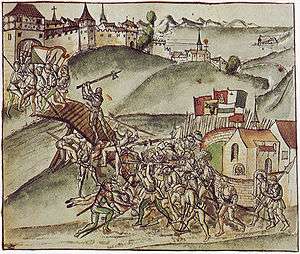
On 1 May 1351, the citizens of Zürich had to swear allegiance before representatives of the cantons of Lucerne, Schwyz, Uri and Unterwalden, the other members of the Swiss Confederacy. Thus, Zürich became the fifth member of the Confederacy, which was at that time a loose confederation of de facto independent states. Zürich was the presiding canton of the Diet from 1468 to 1519. This authority was the executive council and lawmaking body of the confederacy, from the Middle Ages until the establishment of the Swiss federal state in 1848. Zürich was temporarily expelled from the confederacy in 1440 due to a war with the other member states over the territory of Toggenburg (the Old Zürich War). Neither side had attained significant victory when peace was agreed upon in 1446, and Zürich was readmitted to the confederation in 1450.[27]

Zwingli started the Swiss Reformation at the time when he was the main preacher in the 1520s, at the Grossmünster. He lived there from 1484 until his death in 1531. The Zürich Bible, based on that of Zwingli, was issued in 1531. The Reformation resulted in major changes in state matters and civil life in Zürich, spreading also to a number of other cantons. Several cantons remained Catholic and became the basis of serious conflicts that eventually led to the outbreak of the Wars of Kappel.
During the 16th and 17th centuries, the Council of Zürich adopted an isolationist attitude, resulting in a second ring of imposing fortifications built in 1624. The Thirty Years' War which raged across Europe motivated the city to build these walls. The fortifications required a lot of resources, which were taken from subject territories without reaching any agreement. The following revolts were crushed brutally. In 1648, Zürich proclaimed itself a republic, shedding its former status of a free imperial city.[27] In this time the political system of Zürich was an oligarchy (Patriziat): the dominant families of the city were the following ones: Bonstetten, Brun, Bürkli, Escher vom Glas, Escher vom Luchs, Hirzel, Jori (or von Jori), Kilchsperger, Landenberg, Manesse, Meiss, Meyer von Knonau, Mülner, von Orelli.
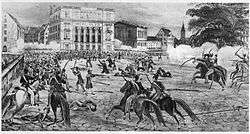
The Helvetic Revolution of 1798 saw the fall of the Ancien Régime. Zürich lost control of the land and its economic privileges, and the city and the canton separated their possessions between 1803–05. In 1839, the city had to yield to the demands of its urban subjects, following the Züriputsch of 6 September. Most of the ramparts built in the 17th century were torn down, without ever having been besieged, to allay rural concerns over the city's hegemony. The Treaty of Zürich between Austria, France, and Sardinia was signed in 1859.[28]
Modern history
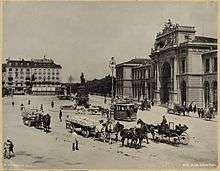
Zürich was the Federal capital for 1839–40, and consequently the victory of the Conservative party there in 1839 caused a great stir throughout Switzerland. But when in 1845 the Radicals regained power at Zürich, which was again the Federal capital for 1845–46, Zürich took the lead in opposing the Sonderbund cantons. Following the Sonderbund war and the formation of the Swiss Federal State, Zürich voted in favour of the Federal constitutions of 1848 and of 1874. The enormous immigration from the country districts into the town from the 1830s onwards created an industrial class which, though "settled" in the town, did not possess the privileges of burghership, and consequently had no share in the municipal government. First of all in 1860 the town schools, hitherto open to "settlers" only on paying high fees, were made accessible to all, next in 1875 ten years' residence ipso facto conferred the right of burghership, and in 1893 the eleven outlying districts were incorporated within the town proper.
Extensive developments took place during the 19th century. From 1847, the Spanisch-Brötli-Bahn, the first railway on Swiss territory, connected Zürich with Baden, putting the Zürich Hauptbahnhof at the origin of the Swiss rail network. The present building of the Hauptbahnhof (the main railway station) dates to 1871. Zürich's Bahnhofstrasse (Station Street) was laid out in 1867, and the Zürich Stock Exchange was founded in 1877. Industrialisation led to migration into the cities and to rapid population growth, particularly in the suburbs of Zürich.
The Quaianlagen are an important milestone in the development of the modern city of Zürich, as the construction of the new lake front transformed Zürich from a small medieval town on the rivers Limmat and Sihl to an attractive modern city on the Zürichsee shore, under the guidance of the city engineer Arnold Bürkli.
In 1893, the twelve outlying districts were incorporated into Zürich, including Aussersihl, the workman's quarter on the left bank of the Sihl, and additional land was reclaimed from Lake Zürich.[29]
In 1934, eight additional districts in the north and west of Zürich were incorporated.
Zürich was accidentally bombed during World War II.
Coat of arms
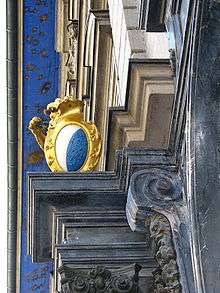
The blue and white coat of arms of Zürich is attested from 1389, and was derived from banners with blue and white stripes in use since 1315 . The first certain testimony of banners with the same design is from 1434. The coat of arms is flanked by two lions. The red Schwenkel on top of the banner had varying interpretations: For the people of Zürich, it was a mark of honour, granted by Rudolph I. Zürich's neighbours mocked it as a sign of shame, commemorating the loss of the banner at Winterthur in 1292. Today, the Canton of Zürich uses the same coat of arms as the city.[30]
Politics
City districts
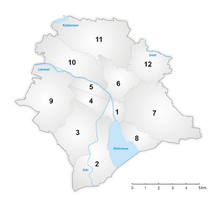
The previous boundaries of the city of Zürich (before 1893) were more or less synonymous with the location of the old town. Two large expansions of the city limits occurred in 1893 and in 1934 when the city of Zürich merged with many surrounding municipalities, that had been growing increasingly together since the 19th century. Today, the city is divided into twelve districts (known as Kreis in German), numbered 1 to 12, each one of which contains between one and four neighborhoods:
- Kreis 1, known as Altstadt, contains the old town, both to the east and west of the start of the Limmat. District 1 contains the neighbourhoods of Hochschulen, Rathaus, Lindenhof, and City.
- Kreis 2 lies along the west side of Lake Zürich, and contains the neighbourhoods of Enge, Wollishofen and Leimbach.
- Kreis 3, known as Wiedikon is between the Sihl and the Üetliberg, and contains the neighbourhoods of Alt-Wiedikon, Sihlfeld and Friesenberg.
- Kreis 4, known as Aussersihl lies between the Sihl and the train tracks leaving Zürich Hauptbahnhof, and contains the neighbourhoods of Werd, Langstrasse, and Hard.
- Kreis 5, known as Industriequartier, is between the Limmat and the train tracks leaving Zürich Hauptbahnhof, it contains the former industrial area of Zürich which has gone under a large-scale rezoning to create upscale modern housing, retail and commercial real estate. It contains the neighborhoods of Gewerbeschule, and Escher-Wyss.
- Kreis 6 is on the edge of the Zürichberg, a hill overlooking the eastern part of the city. District 6 contains the neighbourhoods of Oberstrass and Unterstrass.
- Kreis 7 is on the edge of the Adlisberg hill as well as the Zürichberg, on the eastern side of the city. District 7 contains the neighbourhoods of Fluntern, Hottingen, and Hirslanden. These neighbourhoods are home to Zürich's wealthiest and more prominent residents. The neighbourhood Witikon also belongs to district 7.
- Kreis 8, officially called Riesbach, but colloquially known as Seefeld, lies on the eastern side of Lake Zürich. District 8 consists of the neighbourhoods of Seefeld, Mühlebach, and Weinegg.
- Kreis 9 is between the Limmat to the north and the Üetliberg to the south. It contains the neighbourhoods Altstetten and Albisrieden.
- Kreis 10 is to the east of the Limmat and to the south of the Hönggerberg and Käferberg hills. District 10 contains the neighbourhoods of Höngg and Wipkingen.
- Kreis 11 is in the area north of the Hönggerberg and Käferberg and between the Glatt Valley and the Katzensee (Cats Lake). It contains the neighbourhoods of Affoltern, Oerlikon and Seebach.
- Kreis 12, known as Schwamendingen, is located in the Glattal (Glatt valley) on the northern side of the Zürichberg. District 12 contains the neighbourhoods of Saatlen, Schwamendigen Mitte, and Hirzenbach.
Most of the district boundaries are fairly similar to the original boundaries of the previously existing municipalities before they were incorporated into the city of Zürich.
Government
The City Council (Stadtrat) constitutes the executive government of the City of Zürich and operates as a collegiate authority. It is composed of nine councilors, each presiding over a department. Departmental tasks, coordination measures and implementation of laws decreed by the City Parliament are carried out by the City Council. The regular election of the City Council by any inhabitant valid to vote is held every four years. The mayor (German: Stadtpräsident(in)) is elected as such by a public election while the heads of the other departments are assigned by the collegiate. Current mayor is Corine Mauch. The executive body holds its meetings in the City Hall (Stadthaus), on the left bank of the Limmat. The building was built in 1883 in Renaissance style.
As of 2015, the Zürich City Council is made up of four representatives of the SP (Social Democratic Party, one of whom is the mayor), two members of the FDP (Free Democratic Party) and one member each of Green Party, CVP (Christian Democratic Party) and AL (Alternative Left Party), giving the left parties a combined six out of nine seats.[31] The last election was held on .
| City Councilor (Stadtrat / Stadträtin) | Party | Head of Office (Departement, since) of |
elected since |
|---|---|---|---|
| Corine Mauch[SR 1] | SP | Mayor's Office (Präsidialdepartement, 2009) | 2009 |
| Daniel Leupi | GPS | Finance (Finanzdepartement, 2013) | 2010 |
| Richard Wolff | AL | Police (Polizeidepartement, 2013) | 2013 |
| Claudia Nielson | SP | Health and Environment (Gesundheits- und Umweltdepartement, 2010) | 2010 |
| Filippo Leutenegger | FDP | Civil Engineering and Waste Management (Tiefbau- und Entsorgungsdepartement, 2014) | 2014 |
| André Odermatt | SP | Structural Engineering (Hochbaudepartement, 2010) | 2010 |
| Andres Türler[SR 2] | FDP | Industrial Facilities (Departement der Industriellen Betriebe, 2002) | 2002 |
| Gerold Lauper[SR 3] | CVP | Education and Sports (Schul- und Sportdepartement, 2006) | 2006 |
| Raphael Golta | SP | Social Services (Sozialdepartement, 2014) | 2014 |
Claudia Cuche-Curti is Town Chronicler (Stadtschreiberin) since 2012, and Peter Saile is Legal Counsel (Rechtskonsulent) since 2000 for the City Council.
Parliament
The Gemeinderat of Zurich for the mandate period of 2014–2018
The City Parliament (Gemeinderat) holds the legislative power. It is made up of 125 members (Gemeindrat / Gemeinderätin), with elections also held every four years. The City Parliament decrees regulations and by-laws that are executed by the City Council and the administration. The sessions of the City Parliament are public. Unlike the member of the City Council, the members of the City Parliament are not politicians by profession, but they are paid a fee based on their attendance. Any resident of Zürich allowed to vote can be elected as a member of the City Parliament. The legislative body holds its meetings in the town hall (Rathaus), on the right bank of the Limmat opposite to the City Hall (Stadthaus).[33]
The last election of the City Parliament was held on 9 February 2014 for the mandate period of 2014–2018. Currently the City Parliament consist of 39 members of the Social Democratic Party (SP), 22 members of the Swiss People's Party (SVP), 21 The Liberals (FDP), 14 Green Party (GPS), 13 Green Liberal Party (GLP), 9 Alternative List (AL), 6 Christian Democratic People's Party (CVP), and 1 member without any association to a party.[34]
Elections
National Council
In the 2015 election for the Swiss National Council the most popular party was the SPS which received 31.3% of the vote. The next four most popular parties were the SVP (18.1%), the FDP (14.2%), the GPS (10.7%), the GLP (9.2%). In the federal election, a total of 114,377 voters were cast, and the voter turnout was 46.2%.[35]
International relations
Twin towns and sister cities
Zürich is partnered with two sister cities: Kunming and San Francisco.[36]
Geography
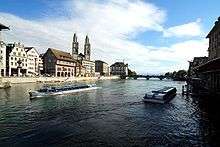
Zürich is situated at 408 m (1,339 ft) above sea level on the lower (northern) end of Lake Zürich (Zürichsee) about 30 kilometers (19 mi) north of the Alps, nestling between the wooded hills on the west and east side. The Old Town stretches on both sides of the Limmat, which flows from the lake, running northwards at first and then gradually turning into a curve to the west. The geographic (and historic) centre of the city is the Lindenhof, a small natural hill on the west bank of the Limmat, about 700 m (2,300 ft) north of where the river issues from Lake Zürich. Today the incorporated city stretches somewhat beyond the natural confines of the hills and includes some districts to the northeast in the Glatt Valley (Glattal) and to the north in the Limmat Valley (Limmattal). The boundaries of the older city are easy to recognize by the Schanzengraben canal. This artificial watercourse has been used for the construction of the third fortress in the 17th and 18th centuries.
Topography
The municipality of Zürich has an area of 91.88 km2 (35.48 sq mi), of which 4.1 km2 (1.6 sq mi) is made up of Lake Zürich. The area includes a section of the northern Swiss Plateau. The banks of the Limmat constitute the densest part of the city. The river is oriented in the southeast-northwest direction, with the flat valley floor having a width of two to three kilometres. The partially channelled and straightened Limmat does not flow in the central part of the valley, but always along its right (northeastern) side. The Sihl meets with the Limmat at the end of Platzspitz, which borders the Swiss National Museum. The Limmat reaches the lowest point of the municipality in Oberengstringen at 392 m (1,286 ft) above sea level.
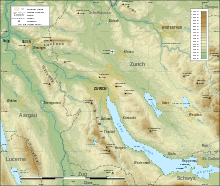
On its west side the Limmat valley is flanked by the wooded heights of the Albis chain, which runs along the western border. The Üetliberg is, with 869 m (2,851 ft) above sea level, the highest elevation of the surrounding area. Its summit can be reached easily by the Uetlibergbahn. From the platform of the observation tower on the summit, an impressive panorama of the city, the lake and the Alps can be seen.
The northeast side of the Limmat valley includes a range of hills, which marks the watershed between the Limmat and the Glatt. From the northwest to the southeast, the height of the mostly wooded knolls generally increases: the Gubrist (615 m or 2,018 ft), the Hönggerberg (541 m or 1,775 ft), the Käferberg (571 m or 1,873 ft), the Zürichberg (676 m or 2,218 ft), the Adlisberg (701 m or 2,300 ft) and the Öschbrig (696 m or 2,283 ft). Between the Käferberg and the Zürichberg is located the saddle of the Milchbuck (about 470 m or 1,540 ft), an important passage from the Limmat valley to the Glatt valley.
The northernmost part of the municipality extends to the plain of the Glatt valley and to the saddle which makes the connection between the Glattal and Furttal. Also a part of the Katzensee (nature reserve) and the Büsisee, both of which are drained by the Katzenbach to Glatt, belong to the city.
Climate
Zürich has, depending on the definition used, an oceanic climate (Köppen Cfb), with four distinct seasons. Decisive for the climate of Zürich are both the winds from westerly directions, which often result in precipitation and, on the other hand, the Bise (east or north-east wind), which is usually associated with high-pressure situations, but cooler weather phases with temperatures lower than the average. The Foehn wind, which plays an important role in the northern alpine valleys also has some impact on Zürich.[37]
The annual mean temperature at the measuring station of the Federal Office of Meteorology and Climatology in Zürich-Fluntern (556 m[1,824 ft] above sea level on the slope of the Zürichberg, 150 m[490 ft] above the level of the city centre) is 9.3 °C (48.7 °F). The lowest monthly mean of daily minimum temperature are measured in January with −2.0 °C (28.4 °F) and the highest monthly mean of daily maximum temperature are measured in July with 24.0 °C (75.2 °F). On average there are 74.9 days in which the minimum temperature is below 0 °C (32 °F) (so-called frost days), and 23.7 days in which the maximum temperature is below 0 °C (32 °F) (so-called ice days). There are on average of 30 so-called summer days (maximum temperature equal to or above 25 °C[77 °F]) throughout the year, while so-called heat days (with maximum temperature equal to or above 30 °C[86 °F]) are 5.8 days.[38]
The average high temperature in July is 24.0 °C (75.2 °F) and average low temperature is 14 °C (57.2 °F). Record high in Zürich was on 13 August 2003 with temperature above 37 °C (99 °F).[39]
Spring and autumn are generally cool to mild, but sometimes with large differences between warm and cold days even during the same year. The highest temperature of the month March in 2014 was on the 20th at 20.6 °C (69.1 °F) during a sunny afternoon and the lowest temperature was on the 25th at −0.4 °C (31.3 °F) during the night/early morning.[40] Record low of average daily temperatures in March since 1864 is −12 °C (10 °F) and record high of average daily temperatures in March is 16 °C (61 °F). Record low of average daily temperatures in October is −16 °C (3 °F) and record high of average daily temperatures in October is 20 °C (68 °F).[41]
Zürich has an average of 1,544 hours of sunshine per year and shines on 38% of its potential time throughout the year. During the months April until September the sun shines between 150 and 215 hours per month. The 1,134 millimetres (44.6 in) rainfall spread on 133.9 days with precipitation throughout the year. Roughly about every third day you will encounter at least some precipitation, which is very much a Swiss average. During the warmer half of the year and especially during the three summer months, the strength of rainfall is higher than those measured in winter, but the days with precipitation stays about the same throughout the year (in average 9.9–12.7 days per month). October has the lowest number (9.9) of days with some precipitation. There is an average of 59.5 so-called bright days (number of days with sunshine duration greater than 80%) through the year, the most in July and August (7.4, 7.7 days), and the least in January and December (2.7, 1.8 days). The average number of days with sunshine duration less than 20%, so-called cloudy days, is 158.4 days, while the most cloudy days are in November (17.8 days), December (21.7 days), and January with 19 days.[38]
| Climate data for Zürich-Fluntern (1981–2010) | |||||||||||||
|---|---|---|---|---|---|---|---|---|---|---|---|---|---|
| Month | Jan | Feb | Mar | Apr | May | Jun | Jul | Aug | Sep | Oct | Nov | Dec | Year |
| Average high °C (°F) | 2.9 (37.2) |
4.6 (40.3) |
9.5 (49.1) |
13.8 (56.8) |
18.5 (65.3) |
21.6 (70.9) |
24.0 (75.2) |
23.3 (73.9) |
18.8 (65.8) |
13.7 (56.7) |
7.2 (45) |
3.7 (38.7) |
13.5 (56.3) |
| Daily mean °C (°F) | 0.3 (32.5) |
1.3 (34.3) |
5.3 (41.5) |
8.8 (47.8) |
13.3 (55.9) |
16.4 (61.5) |
18.6 (65.5) |
18.0 (64.4) |
14.1 (57.4) |
9.9 (49.8) |
4.4 (39.9) |
1.4 (34.5) |
9.3 (48.7) |
| Average low °C (°F) | −2.0 (28.4) |
−1.6 (29.1) |
1.7 (35.1) |
4.5 (40.1) |
8.8 (47.8) |
11.9 (53.4) |
14.0 (57.2) |
13.8 (56.8) |
10.5 (50.9) |
7.0 (44.6) |
2.0 (35.6) |
−0.7 (30.7) |
5.8 (42.4) |
| Average precipitation mm (inches) | 63 (2.48) |
64 (2.52) |
78 (3.07) |
83 (3.27) |
122 (4.8) |
128 (5.04) |
124 (4.88) |
124 (4.88) |
99 (3.9) |
86 (3.39) |
79 (3.11) |
83 (3.27) |
1,134 (44.65) |
| Average snowfall cm (inches) | 18.4 (7.24) |
22.0 (8.66) |
13.7 (5.39) |
3.0 (1.18) |
0.0 (0) |
0.0 (0) |
0.0 (0) |
0.0 (0) |
0.0 (0) |
0.8 (0.31) |
8.0 (3.15) |
19.1 (7.52) |
85.0 (33.46) |
| Average precipitation days (≥ 1.0 mm) | 10.5 | 9.3 | 11.9 | 11.4 | 12.4 | 12.7 | 12.3 | 11.6 | 10.2 | 9.9 | 10.3 | 11.4 | 133.9 |
| Average snowy days (≥ 1.0 cm) | 4.8 | 5.2 | 3.2 | 0.7 | 0.0 | 0.0 | 0.0 | 0.0 | 0.0 | 0.1 | 1.6 | 4.8 | 20.4 |
| Average relative humidity (%) | 83 | 78 | 72 | 69 | 71 | 71 | 71 | 74 | 79 | 83 | 84 | 84 | 77 |
| Mean monthly sunshine hours | 55 | 81 | 124 | 153 | 175 | 189 | 215 | 200 | 150 | 102 | 59 | 42 | 1,544 |
| Percent possible sunshine | 22 | 31 | 36 | 40 | 41 | 44 | 49 | 50 | 44 | 33 | 24 | 18 | 38 |
| Source: MeteoSwiss[42] | |||||||||||||
Climate protection
The city of Zürich is among the world-leaders in protecting the climate by following a manifold approach. In November 2008[43] the people of Zürich voted in a public referendum to write into law the quantifiable and fixed deadline of one tonne of CO2 per person per annum by 2050. This forces any decision of the executive to support this goal, even if the costs are higher in all dimensions. Some examples are the new disinfection section of the public city hospital in Triemli (Minergie-P quality – passive house), the continued optimisation and creation of public transportation, enlargement of the bicycle-only network, research and projects for renewable energy and enclosure of speed-ways.
Urban area
The areas surrounding the Limmat are almost completely developed with residential, industrial, and commercial zones. The sunny and desirable residential areas in the hills overlooking Zürich, Waidberg and Zürichberg, and the bottom part of the slope on the western side of the valley on the Üetliberg, are also densely built.
The "green lungs" of the city include the vast forest areas of Adlisberg, Zürichberg, Käferberg, Hönggerberg and Üetliberg. Major parks are also located along the lakeshore (Zürichhorn and Enge), while smaller parks dot the city. Larger contiguous agricultural lands are located near Affoltern and Seebach. Of the total area of the municipality of Zürich (in 1996, without the lake), 45.4% is residential, industrial and commercial, 15.5% is transportation infrastructure, 26.5% is forest, 11%: is agriculture and 1.2% is water.

Transport
Public transport is extremely popular in Zürich, and its inhabitants use public transport in large numbers. About 70% of the visitors to the city use the tram or bus, and about half of the journeys within the municipality take place on public transport.[44] Within Zürich and throughout the canton of Zürich, the ZVV network of public transport has traffic density ratings among the highest worldwide. When adding frequency, which in Zürich can be as often as seven minutes, it does become the densest across all dimensions. Three means of mass-transit exist: the S-Bahn (local trains), trams, and buses (both diesel and electric, also called trolley buses). In addition, the public transport network includes boats on the lake and river, funicular railways and even the Luftseilbahn Adliswil-Felsenegg (LAF), a cable car between Adliswil and Felsenegg. Tickets purchased for a trip are valid on all means of public transportation (train, tram, bus, boat). The Zürichsee-Schifffahrtsgesellschaft (commonly abbreviated to ZSG) operates passenger vessels on the Limmat and the Lake Zürich, connecting surrounding towns between Zürich and Rapperswil.

Zürich is a mixed hub for railways, roads, and air traffic. Zürich Hauptbahnhof (Zürich HB) is the largest and busiest station in Switzerland and is an important railway hub in Europe. There are between 350,000 and 500,000 commuters daily making use of this central network node – a significant figure in comparison to Zürich's population. Regarding the amount of trains daily entering and leaving a single railway station, Zürich HB is the world's most frequently served railway station, with 2915 trains every day. Among the 16 train stations (and 10 additional train stops) within Zürich's city borders, there are five other major passenger railway stations. Three of them belong to the five most frequented railway stations in Switzerland: Stadelhofen, Oerlikon, Altstetten, Hardbrücke, and Enge. The railway network is mainly operated by the Federal Railways SBB-CFF-FFS but Zürich is also served by major EuroCity trains from the neighbouring countries and is a destination for both French (TGV) and German (ICE) high-speed trains.
Zürich Airport is located less than 10 kilometers (6.2 mi) northeast of the city in Kloten. Zürich Airport has its own railway station, which is located underground. It is directly connected to Zürich and most of the major Swiss cities. Zurich airport is served by more than 60 passenger airlines from around the world. It is also served by one cargo airline and is a hub for Swiss International Air Lines. There is also an airfield in Dübendorf.
The A1, A3 and A4 motorways pass close to Zürich. The A1 heads west towards Bern and Geneva and eastwards towards St. Gallen; the A4 leads northwards to Schaffhausen and southwards to Altdorf connecting with the A2 towards Chiasso; and the A3 heads northwest towards Basel and southeast along Lake Zürich and Lake Walen towards Sargans.
Demographics
Population
There are about 390,000 people living in Zürich (as of 2011),[4] making it Switzerland's largest city. Of registered inhabitants, 31% (121,017) do not hold Swiss citizenship. Of these, German citizens make up the largest group with 8% (31,124), followed by Italians 3.4% (13,144).[6] The population of the city including suburbs totals 1.19 million people.[6] The entire metropolitan area (including the cities of Winterthur, Baden, Brugg, Schaffhausen, Frauenfeld, Uster/Wetzikon, Rapperswil-Jona and Zug) has a population of around 1.83 million people.[6]
| Largest groups of foreign residents 2011[45] | ||
| Nationality | Amount | % total (foreigners) |
|---|---|---|
| 31,124 | 8.0 (25.7) | |
| 13,144 | 3.4 (10.9) | |
| 8,225 | 2.1 (6.8) | |
(incl. Monten. and Kosovo) | 7,772 | 2.0 (6.4) |
| 4,844 | 1.2 (4.0) | |
| 4,251 | 1.1 (3.5) | |
| 3,915 | 1.0 (3.2) | |
| 3,163 | 0.8 (2.6) | |
| 2,846 | 0.7 (2.4) | |
| 2,096 | 0.5 (1.7) | |
Languages
The official formal language used by governmental institutions, print, news, universities/schools, courts, theater and in any kind of written form is (Swiss) Standard German, while the spoken language is Zürich German (Züritüütsch), one of the several more or less distinguishable, but mutually intelligible Swiss German dialects of Switzerland with roots in the medieval Alemannic German dialect groups. However, because of Zürich's national importance, and therefore its existing high fluctuation, one can hear all kinds of Swiss German dialects spoken by its inhabitants and commuters. As of the December 2010 census, 69.3% of the population speaks diglossic Swiss German/Swiss Standard German as their mother-tongue at home. Some 22.7% of inhabitants speak Standard German in their family environment ("at home"). Dramatically increasing, according to the last census in 2000, 8.8% now speak English. Italian follows behind at 7.1% of the population, then French at 4.5%. Other languages spoken here include Croatian and Serbian (4.1%), Spanish (3.9%), Portuguese (3.1%), and Albanian (2.3%). (Multiple choices were possible.) Thus 20% of the population speak two or more languages at home.[46]
Religion
Before the Protestant Reformation reached Zürich, it was de jure and de facto Roman Catholic.
The Protestant Reformation led by Huldrych Zwingli made Zürich both a theological centre and a stronghold of Protestantism in Switzerland. Another Swiss city with a comparable status was Geneva, the so-called Protestant Rome, where John Calvin and his Protestant Reformers operated. Zürich attracted other influential Protestant Reformers like Heinrich Bullinger. Zwingli translated the Bible (Zürich Bible) into the local variety of German and introduced the Reformation by winning support of the magistrates, the princess abbess Katharina von Zimmern and the largely peasant population of the Canton of Zürich. The canton unanimously adopted the Reformed tradition as represented by Zwingli. Religious wars between Catholics and Protestants tormented the Swiss Confederacy. Zwingli died for political and religious reasons by defending the Canton of Zürich in the Battle of Kappel. Bullinger took over his role as the city's spiritual leader.
In 1970, about 53% of the population were Swiss Reformed, while almost 40% were Roman Catholic. Since then both Swiss dominant churches, the Roman Catholic Church and Swiss Reformed Church, have been constantly losing members, though for the Catholic Church the decrease started 20 years later in around 1990. Nevertheless, for the last twenty years both confessions have been reduced by 10% to the current figures (census 2010): 30% Roman Catholic and 26% Swiss Reformed (organized in Evangelical Reformed Church of the Canton of Zürich). In 1970, only 2% of Zürich's inhabitants claimed to be not affiliated with any religious confession. In accordance with the loss by the dominant Swiss churches, the amount of people declaring themselves as non-affiliated rose to 17% in the year 2000. In the last ten years, this figure rose to more than 25%. For the group of people, being between 24 and 44 years old, this is as high as one in every third person. 5% of Zürich's inhabitants are Muslims, a slight decrease of 1% compared to the year 2000. The population of Jewish confession has been more or less constant since 1970 at about 1%.[48]
Nearly 1/10 of city's population is member of non-state-recognized Christian denominations (for example the Eastern Orthodox Church) and more than 6% of Zürich's inhabitants are Muslims.[49] The Mahmood Mosque Zürich, situated in Forchstrasse is the first mosque built in Switzerland.[50] The population of Jewish confession has been more or less constant since 1970 at about 1%.[49] The Synagoge Zürich Löwenstrasse is the oldest and largest synagogue of Zürich.[51] More than 2% of Zürich's population account for non-monotheistic religions (such as Buddhism or Hinduism).[49]
Social
The level of unemployment in Zürich was 3.2%[52] in July 2012. In 2008, the average monthly income was about CHF 7000 before any deductions for social insurances and taxes.[53] In 2010, there were 12,994 cases (in average per month) of direct or indirect welfare payments from the state.[54]
Main sites

Most of Zürich's sites are located within the area on either side of the Limmat, between the Main railway station and Lake Zürich. The churches and houses of the old town are clustered here, as are the most expensive shops along the famous Bahnhofstrasse. The Lindenhof in the old town is the historical site of the Roman castle, and the later Carolingian Imperial Palace.
Churches
- Grossmünster (Great Minster) According to legend, Charlemagne discovered the graves of the city's martyrs Felix and Regula and had built the first church as a monastery; start of current building around 1100; in the first half of the 16th century, the Great Minster was the starting point of the Swiss-German Reformation led by Huldrych Zwingli and Heinrich Bullinger; declared by Charlemagne imperial church; romanesque crypt, romanesque capitals in the church and cloister; choir windows by Augusto Giacometti (1932) and Sigmar Polke (2009), bronze doors by Otto Münch (1935 and 1950).[55]
- Fraumünster (Women's Minster) Church of a former abbey for aristocratical women from southern Germany which was founded in 853 by Louis the German for his daughter Hildegard; first church built before 874; the romanesque choir dates from 1250–70; the church enjoyed the patronage of kings and had the right of coinage from Zürich to the 13th century; after the Reformation, church and convent passed into the possession of the city; the most important jewelry – in addition to the largest organ in the canton with its 5,793 pipes and 92 stops – are color windows: the window in the north transept of Augusto Giacometti (1945), the five-part cycle in the choir (1970) and the rosette in the southern transept (1978) are by Marc Chagall; also the church of Zürich's largest choir with 100 and more singers.[56]
- St. Peter romanesque-gothic-baroque church built on remains of former churches from before the 9th century; with the largest church clock face in Europe built 1538; baptismal font of 1598, baroque stucco; individual stalls from the 15th century from city repealed monasteries with rich carvings and armrests; Kanzellettner (increased barrier between the nave and choir with built-pulpit) of 1705 pulpit sounding board about 1790; rich Akanthus embellishment with Bible verse above the pulpit; 1971 new crystal chandelier modeled according 1710 design; organ in 1974 with 53 stops; Bells: five from 1880, the largest, A minor, without clapper weighs about 6,000 kg (13,228 lb); fire guard in the tower to the Middle Ages to 1911.[57]
- Predigerkirche is one of the four main churches of the old town, first built in 1231 AD as a Romanesque church of the then Dominican Predigerkloster nearby the Neumarkt. It was converted in the first half of the 14th century, and the choir rebuilt between 1308 and 1350. Due to its construction and for that time unusual high bell tower, it was regarded as most high Gothic edifice in Zürich.
Museums
- Zürich Museum of Art – The Museum of Art, also known as Kunsthaus Zürich, is one of the significant art museums of Europe. It holds one of the largest collections in Classic Modern art in the world (Munch, Picasso, Braque, Giacometti, etc.). The museum also features a large library collection of photographs.[58]
- Swiss National Museum – The National Museum (German: Landesmuseum) displays many objects that illustrate the cultural and historical background of Switzerland. It also contains many ancient artifacts, including stained glass, costumes, painted furniture and weapons. The museum is located in the Platzspitz park opposite to the Hauptbahnhof.[59]
- Centre Le Corbusier – Located on the shore of the Lake Zürich nearby Zürichhorn, the Centre Le Corbusier (also named: Heidi Weber Museum), is an art museum dedicated to the work of the Swiss architect Le Corbusier, inside the last house he designed.
- Rietberg Museum – The Rietberg Museum, situated in Gablerstrasse, is one of the great repositories of art and culture in Zürich. The museum also displays exhibits gathered from various corners of the world: bronze artifacts from Tibet, ceramics and jade, Indian sculpture, Chinese grave decorations, masks by African tribes etc.
- Museum of Design – The Museum of Design is a museum for industrial design, visual communication, architecture and craft. It is part of the Department of Cultural Analysis of the Zürich University of the Arts.[60]
- Haus Konstruktiv – The Haus Konstruktiv is a museum with Swiss-wide and international recognition. The museum is about constructive, concrete and conceptual art and design. It testimonies to Zürich's industrial architecture in the immediate vicinity of the Main Station.[61]
- Uhrenmuseum Beyer – The Uhrenmuseum is located in the heart of the city. Documenting the history of timekeeping and timekeepers, the museum is home to a large collection of mechanical timepieces as well as a collection of primitive time keeping devices such as water clocks, sundials and hourglasses
- No Show Museum – the No Show Museum is the first museum dedicated to nothing and its various manifestations throughout the history of art.
- Guild houses – The Guild houses (German: Zunfthaus) are located along the Limmat (downstream from the Grossmünster): Meisen (also a porcelain and fayence museum), Rüden, Haue, Saffran, Schneidern, Schmiden, Zimmerleuten, and some more.
- Tram Museum – The Tram Museum is located at Burgwies in Zürich's eastern suburbs, and chronicles the history of Zürich's iconic tram system with exhibits varying in date from 1897 to the present day.
- North America Native Museum – The North American Native Museum specializes in the conservation, documentation and presentation of ethnographic objects and art of Native American, First Nation and Inuit cultures.
Parks and nature
- Zoological Garden – The zoological garden holds about 260 species of animals and houses about 2200 animals. One can come across separate enclosures of snow leopards, India lions, clouded leopards, Amur leopards, otters and pandas in the zoo.[62]
- Botanical Garden – The Botanical Garden houses about 15,000 species of plants and trees and contains as many as three million plants. In the garden, many rare plant species from south western part of Africa, as well as from New Caledonia can be found. The University of Zürich holds the ownership of the Botanical Garden.
- Chinese Garden – The Chinese Garden is a gift by Zürich's Chinese partner town Kunming, as remiscence for Zürich's technical and scientific assistance in the development of the Kunming city drinking water supply and drainage. The garden is an expression of one of the main themes of Chinese culture, the «Three Friends of Winter» – three plants that together brave the cold season – pine, bamboo, and plum.
- Üetliberg – Located to the west of the city at an altitude of 813 meters (2,667 ft) above sea level, the Üetliberg is the highest hill and offers views over the city. The summit is easily accessible by train from Zürich main station.[63]
Architecture

Compared to other cities, there are few tall buildings in Zürich. The municipal building regulations (Article 9)[65] limit the construction of high-rise buildings to areas in the west and north of the city. In the industrial district, in Altstetten and Oerlikon, buildings up to 80 meters (260 ft) in height are allowed (high-rise area I). In the adjacent high-rise areas II and III the height is limited to 40 meters (130 ft). Around the year 2000, regulations became more flexible and high-rise buildings were again planned and built. The people's initiative "40 meters is enough," which would have reduced both the maximum height and the high-rise buildings area, was clearly rejected on 29 November 2009.[66] At this time in Zürich about a dozen high-rise buildings were under construction or in planning, including the Prime Tower as the tallest skyscraper in Switzerland.

World heritage sites
The prehistoric settlements at Enge Alpenquai and Grosser Hafner and Kleiner Hafner are part of the Prehistoric Pile dwellings around the Alps a UNESCO World Heritage Site.[67]
Economy
Zürich is a leading financial center and global city.[9] The Greater Zürich Area is Switzerland's economic centre and home to a vast number of international companies. By far the most important sector in the economy of Zürich is the service industry, which employs nearly four-fifths of workers. Other important industries include light industry, machine and textile industries and tourism. Most Swiss banks have their headquarters in Zürich and there are numerous foreign banks in the Greater Zürich Area. Located in Zürich, the Swiss Stock Exchange was established in 1877 and is nowadays the fourth most prominent stock exchange in the world. In addition Zürich is the world's largest gold trading centre. Ten of the country's 50 largest companies have their head offices in Zürich, among them ABB, UBS,[68] Credit Suisse, Swiss Re and Zürich Financial Services.[69]
Contributory factors to economic strength
The high quality of life has been cited as a reason for economic growth in Zürich. The consulting firm Mercer has for many years ranked Zürich as a city with the highest quality of life in the world.[11][12] In particular, Zürich received high scores for work, housing, leisure, education and safety. Local planning authorities ensure clear separation between urban and recreational areas and there are many protected nature reserves.[70] Other Swiss cities, Bern and Geneva, were also listed among the top ten. Zürich is also ranked the sixth most expensive city in the world. In 2008, Zürich was ranked ninth. The city ranked behind Hong Kong and ahead of Copenhagen. It is the third most expensive city in Europe and second most expensive city in Switzerland after Geneva.[71]
Zürich benefits from the high level of investment in education that is typical of Switzerland in general and provides skilled labour at all levels. The city is home to two major universities, thus enabling access to graduates and high technology research. Professional training incorporates a mix of practical work experience and academic study while, in general, emphasis is placed on obtaining a good level of general education and language ability. As a result, the city is home to many multilingual people and employees generally demonstrate a high degree of motivation and a low level of absenteeism. Such characteristics are reflected in the high level of productivity the region enjoys and account for the opening of offices and research centres in the city by large corporations.[70]
The Swiss stock exchange
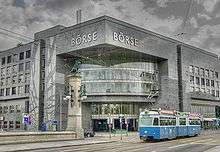
The Swiss stock exchange is called SIX Swiss Exchange, formerly known as SWX. The SIX Swiss Exchange is the head group of several different worldwide operative financial systems: Eurex, Eurex US, EXFEED, STOXX, and virt-x. The exchange turnover generated at the SWX was in 2007 of 1,780,499.5 million CHF; the number of transactions arrived in the same period at 35,339,296 and the Swiss Performance Index (SPI) arrived at a total market capitalization of 1,359,976.2 million CHF.[72][73]
The SIX Swiss Exchange goes back more than 150 years. In 1996, fully electronic trading replaced the traditional floor trading system at the stock exchanges of Geneva (founded in 1850), Zürich (1873) and Basel (1876).
Since 2008, the SIX Swiss Exchange has been part of the SIX Group, as SWX Group, SIS Group and Telekurs Group merged.
Education and research
About 60,000 people study at the 20 universities, colleges and institutions of higher education in Zürich. Two of Switzerland's most distinguished universities are located in the city. The Swiss Federal Institute of Technology (ETH Zürich) which is controlled by the (federal) state and the University of Zürich that is under direction of the canton of Zürich. Both universities were listed in the top 50 world universities rated in 2007.[74]
ETH was founded in 1854 by the Swiss Confederation and opened its doors in 1855 as a polytechnic institute. ETH achieved its reputation particularly in the fields of chemistry, mathematics and physics and there are 21 Nobel Laureates who are associated with the institution. ETH is usually ranked the top university in continental Europe.[75] The institution consists of two campuses, the main building in the heart of the city and the new campus on the outskirts of the city.
The University of Zürich was founded in 1833, although its beginnings date back to 1525 when the Swiss reformer Ulrich Zwingli founded a college of theology. Nowadays with its 24,000 students and 1,900 graduations each year, the University of Zürich is the largest in Switzerland and offers the widest range of subjects and courses at any Swiss higher education institution.
The Pedagogical College, the Zürich University of Applied Sciences (ZHAW) and the Zürich University of the Arts (ZHdK) are another three top-class technical colleges which contribute to Zürich's reputation as a knowledge and research pole by providing applied research and development. Zürich is also one of the co-location centres of the Knowledge and Innovation Community (Climate Change Mitigation and Adaptation) of the European Institute of Innovation and Technology.[76]
State universities by size in Canton Zürich
Only (federal) state Universities and higher education institutions,
| Institution | Total students |
|---|---|
| University of Zürich – UZH | 25,618 |
| Zürich University of Applied Sciences – ZHAW | 15,334 |
| Swiss Federal Institute of Technology Zürich – ETH | 15,093 |
List of largest universities by enrollment in Switzerland
Media
Many large Swiss media conglomerates are headquartered in Zürich, such as tamedia, Ringier and the NZZ-Verlag. Zürich is one of the most important media locations in the German-speaking part of the country. This status has been recently reinforced by the increase in availability of online publications published in Zürich.
Television and radio
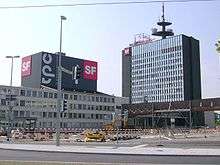
The headquarters of Switzerland's national licence fee funded German language television network ("SF") are located in the Leutschenbach neighborhood, to the north of the Oerlikon railway station. Regional commercial television station "TeleZüri" (Zürich Television) has its headquarters near Escher-Wyss Platz. The production facilities for other commercial stations "Star TV", "u1" TV and "3+" are located in Schlieren.
One section of the Swiss German language licence fee funded public radio station "Schweizer Radio DRS" is located in Zürich. There are commercial local radio stations broadcasting from Zürich, such as "Radio 24" on the Limmatstrasse, "Energy Zürich" in Seefeld on the Kreuzstrasse, Radio "LoRa" and "Radio 1". There are other radio stations that operate only during certain parts of the year, such as "CSD Radio" (May/June), "Radio Streetparade" (July/August) and "rundfunk.fm" (August/September).
Print media
There are three large daily newspapers published in Zürich that are known across Switzerland. The Neue Zürcher Zeitung (NZZ), the Tages-Anzeiger and the Blick, the largest Swiss tabloid. All three of those newspapers publish Sunday editions. These are the "NZZ am Sonntag", "SonntagsZeitung" and "SonntagsBlick". Besides the three main daily newspapers, there are free daily commuter newspapers which are widely distributed: 20 Minuten (20 minutes), published weekdays in the mornings and Blick am Abend,[77] weekdays but in the late afternoon.
There are a number of magazines from major publishers that are based in Zürich. Some examples are: Bilanz, Die Weltwoche, and Annabelle.
Culture
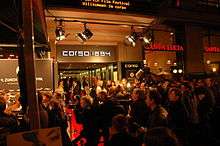
Zürich has a rich cultural tradition. In addition to high-quality museums and galleries, Zürich has high-calibre chamber and symphony orchestras and several important theatres.[78]
The Zürich Film Festival is one of the most important upcoming international film festivals. In just a few years, the Festival became firmly established upon the national and international festival landscape. Over the course of 11 days, it attracts both stars and new talents and celebrates popular international productions.[79] More recently, the kickstarter.com funded Mobile Motion Film Festival held its first event in May 2015.[80]
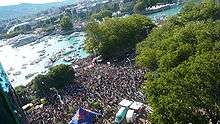
One of the largest and most popular annual events in Zürich is the Street Parade, which is also one of the largest techno and dance music festivals in the world. Proceeding along the side of Lake Zürich, it normally occurs on the second Saturday in August. The first edition was held in 1992 with about 1,000 participants. By 2001 the event had reached the size of 1 million participants.[81][82] The Zürifäscht, on the other hand, is a triennial public festival. It features music, fireworks set to music,[82] and other attractions throughout the old town. It is the largest public festival in Switzerland and is attended by up to 2 million visitors.[83]
The Kunst Zürich is an international contemporary art fair with an annual guest city; it combines most recent and youngest art with the works of well-established artists.[84] Another annual public art exhibit is the city campaign, sponsored by the City Vereinigung (the local equivalent of a chamber of commerce) with the cooperation of the city government. It consists of decorated sculptures distributed over the city centre, in public places. Past themes have included lions (1986), cows (1998), benches (2003), teddy bears (2005), and huge flower pots (2009). From this originated the concept of the CowParade that has been featured in other major world cities.
Zürich is also the home to several art movements. The Cabaret Voltaire where the Dada movement was founded in 1916. Constructive Art movement took also one of the first steps in Zürich. Artists like Max Bill, Marcel Breuer, Camille Graeser or Richard Paul Lohse had their ateliers in Zürich, which became even more important after the takeover of power by the Nazi-Regime in Germany and World War II.
The best known traditional holiday in Zürich is the Sechseläuten (Sächsilüüte), including a parade of the guilds and the burning of "winter" in effigy at the Sechseläutenplatz. Another is the Knabenschiessen target shooting competition for teenagers (originally boys, open to female participants since 1991).
Opera, ballet and theaters

The Zürich Opera House (German: Zürcher Opernhaus) is one of the principal opera houses in Europe. Built in 1834, it was the first permanent theatre in the heart of Zürich and was at the time, the main seat of Richard Wagner's activities. Later in 1890, the theatre was re-built as an ornate building with a neo-classical architecture. The portico is made of white and grey stone ornamented with the busts of Wagner, Weber and Mozart. Later, busts of Schiller, Shakespeare and Goethe were also added. The auditorium is designed in the rococo style. Once a year, it hosts the Zürcher Opernball with the President of the Swiss Confederation and the economic and cultural élite of Switzerland.[85] The Ballet Zürich performs at the opera house.
The Schauspielhaus Zürich is the main theatre complex of the city. It has two dépendances: Pfauen in the Central City District and Schiffbauhalle, an old industrial hall, in Zürich West. The Schauspielhaus was home to emigrants such as Bertolt Brecht or Thomas Mann, and saw premieres of works of Max Frisch, Friedrich Dürrenmatt, Botho Strauss or Elfriede Jelinek. The Schauspielhaus is one of the most prominent and important theatres in the German-speaking world.[86]
The Theater am Neumarkt is one of the oldest theatres of the city. Established by the old guilds in the Old City District, it is located in a baroque palace near Niederdorf Street. It has two stages staging mostly avantgarde works by European directors.
The Zürcher Theater Spektakel is an international theatre festival, ranking among the most important European festivals for contemporary performing arts.[87]
Food
The traditional cuisine of Zürich consists of traditional fare, reflecting the centuries of rule by patrician burghers as well as the lasting imprint of Huldrych Zwingli's puritanism. Traditional dishes include Zürcher Geschnetzeltes and Tirggel.
Nightlife and clubbing
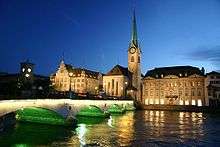
Zürich offers a great deal of variety when it comes to night-time leisure. It is the host city of the world-famous Street Parade, which takes place in August every year.
The most famous districts for Nightlife are the Niederdorf in the old town with bars, restaurants, lounges, hotels, clubs, etc. and a lot of fashion shops for a young and stylish public and the Langstrasse in the districts 4 and 5 of the city. There are authentic amusements: bars, punk clubs, HipHop stages, caribbean restaurants, arthouse cinemas, Turkish kebabs and Italian espresso-bars, but also sex shops or the famous red light district of Zürich.
In the past ten years new parts of the city have risen into the spotlight. Notably, the area known as Zürich West in district 5, near the Escher-Wyss square and the S-Bahn Station of Zürich Hardbrücke.
Sports
Several international sport federations are located in the city:
Association football is an essential aspect of sports in Zürich. The city is home to two major Swiss football teams; Grasshopper Club Zürich founded in 1886 and listed in Switzerland's highest league and FC Zürich, playing in the Switzerland's second division, which has existed since 1896. The Fédération Internationale de Football Association (FIFA) is headquartered in the city. In 2007 were inaugurated the new FIFA headquarters building, designed by architect Tilla Theus
Among the most popular sports in Switzerland is ice hockey. In Zürich it is represented by the ZSC Lions. The International Ice Hockey Federation (IIHF) officiating as head organisation for ice hockey leagues worldwide is based in Zürich as well.
Biking is a popular sport as well as a mean of transport in Zürich. Biking routes are generally marked with red and white signs and the yellow lanes are exclusively meant for the bikers. Also hiking trails are well marked with yellow signs, which give the hiker the probable time it will take him to reach his destination. There are specific maps available for hiking and walking trails throughout Switzerland. Some of the most accessible walks in the Zürich area are the Üetliberg and the Zürichberg.
As many as 30 clubs and 7 indoor Curling facilities can be found in the greater Zürich area. The Curling season starts in early September and continues until the end of April.[88]
Events

Weltklasse Zürich, sometimes referred to as the one-day Olympics, is one of prestigious one day athletics meet held annually at the Letzigrund Stadium. The Weltklasse is reputed as one of the best and most classy athlete meet in the world after the Olympics. Since it started on 12 August 1928, the sporting event has witnessed new world records and national records. To date as many as 24 world records were set in Weltklasse.[89][90][91]
Zürich Marathon is a popular sport event, inviting numerous athletes from every corner of the globe. Zürich Marathon is a long distance running event, covering 42.195 kilometers (26.219 mi) at one stretch. The running course starts from Zürich and passes through Bahnhofstrasse, Bellevueplatz, Mythenquai, Quaibrücke, Talstrasse and Utoquai, and along Lake Zürich to several other places. New Year's Eve run is another important running event. The race is held on 1 January each year and the start takes place at midnight exactly.
Zürich was one of six venues of the 1954 FIFA World Cup and one of eight venues of the UEFA Euro 2008. The Euro 2008 games were held in the Letzigrund Stadium. Work on the new Letzigrund was completed in exceptionally quick time and the stadium opened in August 2007 just one year after the demolition of the old arena.
Zürich hosted six times the UCI Track Cycling World Championships at the Oerlikon Velodrome. The first time was in 1929 and the last time in 1983.
Since 2013, the international Openair Literatur Festival Zürich takes place annually in Zurich, presented by Literaturhaus Zürich and Kaufleuten.
Zürich also hosted the 1998 World Ice Hockey Championships. The city previously co-hosted the 1953 and 1939 editions.
Zürich was also host to the 2012 Men's World Floorball Championships. This was the first time the event had been held in Zürich.
Notable people
Further reading
Architecture
- Hönig, Roderick: Zürich wird gebaut. Architekturführer Zürich 1990–2010. Hochparterre, Zürich 2010, ISBN 978-3-85881-127-1.
- Oechslin, Werner: Hochschulstadt Zürich. Bauten der ETH 1855–2005. GTA, Zürich 2005, ISBN 3-85676-154-3.
- Bonte, Alexander, Bürkle, J. Christoph: Max Dudler Die neue Dichte – Der neue Stadtteil Europaallee und die Pädagogische Hochschule Zürich, Jovis, Berlin 2012, ISBN 978-3-86859-198-9
Culture
- Kröger, Ute: Zürich, du mein blaues Wunder. Literarische Streifzüge durch eine europäische Kulturstadt. Limmat, Zürich 2004, ISBN 3-85791-447-5.
- Staub, Ueli: Jazzstadt Zürich. Von Louis Armstrong bis Zurich Jazz Orchestra. Neue Zürcher Zeitung, Zürich 2003, ISBN 3-03823-012-X.
Others
- Foppa, Daniel: Berühmte und vergessene Tote auf Zürichs Friedhöfen. Limmat, Zürich 2003, ISBN 3-85791-446-7.
- Hegi, Christof u. a.: Zürich. Mairs, Ostfildern 2006, ISBN 3-8297-0315-5 (= Marco Polo Reiseführer).
- Heimgartner, Susanna: Zürich komplett. Regenbogen, Zürich 2005, ISBN 3-85862-458-6 (= Regenbogen Reiseführer).
- Smith, Duncan J. D.: Nur in Zürich – Ein Reiseführer zu einzigartigen Orten, geheimen Plätzen und ungewöhnlichen Sehenswürdigkeiten (übersetzt von Walter Goidinger), Brandstätter, Wien 2012, ISBN 978-3-85033-546-1.
See also
References
- ↑ Arealstatistik Standard - Gemeindedaten nach 4 Hauptbereichen
- ↑ Canton of Zurich Statistical Office (German) accessed 27 April 2016
- ↑ "Zürich entry at the Swiss Tourist Board". Myswitzerland.com. Retrieved 3 July 2010.
- 1 2 "Stadt Zürich wächst auf über 390 000 Personen" (Press release). Präsidialdepartement der Stadt Zürich (Department of the Mayor). 1 March 2012. Retrieved 26 September 2012.
- ↑ "Population size and population composition – Data, indicators – Agglomerations: Permanent resident population in urban and rural areas". www.bfs.admin.ch (Statistics). Federal Statistical Office, Neuchâtel, Swiss Federal Administration. 2015. Retrieved 2015-09-01.
- 1 2 3 4 "Zürich in Zahlen 2011 Taschenstatistik (German)" (Press release). Präsidialdepartement der Stadt Zürich (Department of the Mayor). 8 September 2012. Retrieved 25 September 2012.
- ↑ Primas, Margarita (December 1981). "Urgeschichte des Zürichseegebietes im Überblick: Von der Steinzeit bis zur Früheisenzeit". Helvetia Archaeologica 45/48: 5–18,5f.
- ↑ "Huldrych-Zwingli". Zuerich.com. Retrieved 22 September 2013.
- 1 2 World's 10 Most Powerful Cities prlog.org. Retrieved 10 March 2010
- ↑ "Quality of Life Survey 2012". Monocle. Retrieved 1 August 2012.
- 1 2 "2007 World-wide quality of living survey". Mercer. 2 April 2007. Retrieved 8 August 2008.
- 1 2 "Mercer's 2008 Quality of Living survey highlights". Mercer. 10 June 2008. Retrieved 8 August 2008.
- ↑ Mercer – Quality of Living global city rankings 2009 – Mercer survey, 28 April 2009
- ↑ "Global Liveability Ranking 2015". The Economist Intelligence Unit. Retrieved 18 August 2015.
- ↑ Museums and galleries zurich-relocation.ch. Retrieved 10 March 2010
- ↑ Zurich Culture worldtravelguide.net. Retrieved 10 March 2010
- ↑ "Zurigo: Switzerland". Geographical Names. Retrieved 15 August 2011.
- ↑ Jones, Daniel (1997). English Pronouncing Dictionary. Cambridge: Cambridge UP. p. 559. ISBN 0-521-45903-6.
- ↑ Andres Kristol, Zürich ZH (Zürich) in: Dictionnaire toponymique des communes suisses – Lexikon der schweizerischen Gemeindenamen – Dizionario toponomastico dei comuni svizzeri (DTS|LSG), Centre de dialectologie, University of Neuchâtel, Verlag Huber, Frauenfeld/Stuttgart/Wien 2005, ISBN 3-7193-1308-5 und Éditions Payot, Lausanne 2005, ISBN 2-601-03336-3, p. 992f.
- ↑ Zürcher Ortsnamen – Entstehung und Bedeutung, H. Kläuli, V. Schobinger, Zürcher Kantonalbank (1989), p. 109.
- ↑ "Visiting Zürich – the village- swissinfo". Swissinfo.ch. 26 December 2005. Retrieved 13 May 2012.
- ↑ Drack, Walter; Fellmann, Rudolf (1988). Die Römer in der Schweiz (in German). Stuttgart: Konrad Theiss. p. 571. ISBN 3806204209.
- ↑ Early History of Zürich Archived 3 April 2015 at the Wayback Machine.
- ↑ Zürich as the part of the German Empire Archived 4 March 2012 at the Wayback Machine.
- ↑ Ingeborg Glier, reviewing Koschorreck and Werner 1981 in Speculum 59.1 (January 1984), p 169.
- ↑ Koschorreck and Werner 1981 discern no fewer than eleven scribes, some working simultaneously, in the production.
- 1 2 "History of Zurich". europe-cities.com.
- ↑ New International Encyclopedia
- ↑ "Zurich, Switzerland (Capital)". Encyclopædia Britannica 1911. Retrieved 30 October 2013.
- ↑ Markus G. Jud, Lucerne, Switzerland. "Switzerland's Regional Coats of Arms". geschichte-schweiz.ch.
- ↑ "Der Stadtrat von Zürich" (official site) (in German). Zurich: City of Zurich. 2015. Retrieved 2015-10-27.
- ↑ "Mitglieder des Stadtrats von Zürich" (official site) (in German). Zurich: City of Zurich. 2015. Retrieved 2015-10-27.
- ↑ "Über den Gemeinderat" (official site) (in German). Zürich: Gemeinderat der Stadt Zürich. Retrieved 2015-10-27.
- ↑ "Parteien und Fraktionen" (official site) (in German). Zürich: Gemeinderat der Stadt Zürich. Retrieved 2015-10-27.
- ↑ "Nationalratswahlen 2015: Stärke der Parteien und Wahlbeteiligung nach Gemeinden" (XLS) (official statistics) (in German and French). Neuchâtel, Switzerland: Swiss Federal Statistical Office. 4 March 2016. Retrieved 2016-08-03.
- ↑ "Twin Cities". City of Zürich. Retrieved 14 November 2014.
- ↑ "Föhn" (in German). Zurich-Airport, Switzerland: Swiss Federal Office of Metreology and Climatology, MeteoSwiss. 1 December 2014. Retrieved 3 April 2015.
- 1 2 "Climate normals Zürich / Fluntern (Reference period 1981−2010)" (PDF). Zurich-Airport, Switzerland: Swiss Federal Office of Metreology and Climatology, MeteoSwiss. 2 July 2014. Retrieved 3 April 2015.
- ↑ "Das Wetter im Jahr 2003: Sonnig, trocken und extrem heiss im Sommer" (PDF). statistik.info (in German). Zürich, Switzerland: Statistisches Amt des Kanton Zürichs. 2004. p. 11. Retrieved 3 April 2015.
- ↑ "Klimabulletin März 2014" (PDF) (in German). Zurich-Airport, Switzerland: Swiss Federal Office of Metreology and Climatology, MeteoSwiss. 9 April 2014. p. 5. Retrieved 3 April 2015.
- ↑ "Zürich/Fluntern (556m) 2015" (PDF). Zurich-Airport, Switzerland: Swiss Federal Office of Metreology and Climatology, MeteoSwiss. Retrieved 3 April 2015.
- ↑ "Climate normals Zurich / Fluntern (Reference period 1981−2010)" (PDF). Zurich-Airport, Switzerland: Swiss Federal Office of Metreology and Climatology, MeteoSwiss. 2 July 2014. Retrieved 2016-01-26.
- ↑ "Results of the vote of 30. November 2008" (in German). Retrieved 26 March 2011.
- ↑ Public transportation Zürich-relocation.com. Retrieved 26 June 2010
- ↑ "STATISTISCHES JAHRBUCH DER STADT ZÜRICH 2013" (PDF) (Year Book) (in German). Stadt Zürich, Präsidialdepartement, Statistik Stadt Zürich. 2013. pp. 53–55. Retrieved 23 July 2014.
data from 2011
- ↑ "Wie spricht Zürich?" (Publication). Statistikdepartment der Stadt Zürich (Department of statistics). 6 September 2012. Retrieved 25 September 2012.
- ↑ "STATISTISCHES JAHRBUCH DER STADT ZÜRICH 2014" (PDF) (Year Book) (in German). Stadt Zürich, Präsidialdepartement, Statistik Stadt Zürich. 2014. p. 37. Retrieved 9 March 2015.
- ↑ Simon Villiger (18 September 2012). "Etablierte Kirchen in Bedrängnis (German)" (Web publication). Präsidialdepartement der Stadt Zürich (Department of the Mayor). Retrieved 2016-09-22.
- 1 2 3 "Ständige Wohnbevölkerung ab 15 Jahren nach Religionszugehörigkeit und grosse Städte, 2014 (German)" (Web publication). Federal Statistical Office. 2016. Retrieved 22 September 2016.
- ↑ Marius Egger (4 May 2007). "Minarett? "Kein Problem!" (German)". 20minuten.ch. Retrieved 22 September 2016.
- ↑ "Synagoge" (in German). Die Israelitische Cultusgemeinde Zürich (ICZ). Retrieved 2015-01-25.
- ↑ "Arbeitslose" (Web publication). Präsidialdepartement der Stadt Zürich (Department of the Mayor). July 2012. Retrieved 26 September 2012.
- ↑ "Löhne" (Web publication). Präsidialdepartement der Stadt Zürich (Department of the Mayor). 2008. Retrieved 26 September 2012.
- ↑ "Statistisches Jahrbuch der Stadt Zürich 2012 Kapitel 14: Soziale Sicherheit und Gesundheit" (Year book). Präsidialdepartement der Stadt Zürich (Department of the Mayor). 16 February 2012. Retrieved 26 September 2012.
- ↑ "Zur Geschichte des Grossmünsters" (official website) (in German). Evangelisch-reformierte Landeskirche des Kantons Zürich. Retrieved 29 December 2014.
- ↑ "Geschichte" (official website) (in German). Evangelisch reformierte Kirchgemeinde Fraumünster. Retrieved 29 December 2014.
- ↑ "Aus der Geschichte der Kirche St. Peter Zürich" (official website) (in German). Evangelisch-reformierte Kirchgemeinde St. Peter. Retrieved 29 December 2014.
- ↑ "Kunsthaus Zürich – das Kunstmuseum in Zürich". Kunsthaus.ch. 30 June 2008. Retrieved 22 September 2013.
- ↑ Swiss National Museums Archived 27 October 2005 at the Wayback Machine.
- ↑ "Home Museum Gestaltung". Museum-gestaltung.ch. Retrieved 22 September 2013.
- ↑ "Haus Konstruktiv". Hauskonstruktiv.ch. Retrieved 22 September 2013.
- ↑ Zoo.ch Archived 28 September 2007 at the Wayback Machine.
- ↑ "Uetliberg – Zürich – Your city – Official Website of Zürich Tourism". Zuerich.com. Retrieved 22 September 2013.
- ↑ "BASE jumping :: BASEJumping.tv @ BLiNC Magazine". Blincmagazine.com. Retrieved 13 May 2012.
- ↑ Stadtverwaltung Zuerich. "Bauordnung der Stadt Zürich". Stadt-zuerich.ch. Retrieved 13 May 2012.
- ↑ 40 Meter sind den Zürchern nicht genug. Tages Anzeiger. Retrieved 5 December 2009
- ↑ "UNESCO World Heritage Site – Prehistoric Pile dwellings around the Alps". UNESCO. 27 June 2011. Retrieved 13 May 2012.
- ↑ "UBS AG in Zürich, Bahnhofstrasse 45." (PDF) UBS. Retrieved 2 July 2010.
- ↑ Zürich bcg.thetime.co.uk. Retrieved 26 June 2010
- 1 2 Zürich: Overview USA Today. Retrieved 26 June 2010
- ↑ "Worldwide Cost of Living survey 2009". Mercer.com. Retrieved 22 September 2013.
- ↑ SWX.com Market capitalization of listed securities, 2000–2007
- ↑ SWX.com Key figures: annual turnover and trades, 1998–2007
- ↑ "Newsweek Ranking" (PDF). Retrieved 3 July 2010.
- ↑ ETH Zurich (Swiss Federal Institute of Technology) topuniversities.com. Retrieved 30 April 2010
- ↑ "Climate Change Mitigation and Adaptation" (PDF). Knowledge and Innovation Community. Archived from the original (PDF) on 10 April 2014. Retrieved 9 February 2010.
- ↑ "Blickamabend.ch". Retrieved 3 July 2010.
- ↑ "Zürich". Worldtravelguide.net. Retrieved 22 September 2013.
- ↑ info@blue-compass.com. "Zürich Film Festival". Festivalfocus.org. Retrieved 22 September 2013.
- ↑ "Die Sieger des 1. MoMo Film Festival". t.cineman.ch. Cineman. Retrieved 28 November 2015.
- ↑ "Street Parade". Travelguide.all-about-switzerland.info. Retrieved 22 September 2013.
- 1 2 "Zürich festivals". Markstravelnotes.com. 20 January 2008. Retrieved 3 July 2010.
- ↑ "Zürifäscht 2010". Zuerifaescht.ch. Retrieved 15 June 2010.
- ↑ "Kunst Zürich 2007 | Kunstmesse Zürich". Kunstzuerich.ch. Retrieved 6 May 2009.
- ↑ Zürich: Swiss urbanism at its best Archived 30 November 2010 at the Wayback Machine.
- ↑ "Zürich Culture". Worldtravelguide.net. Retrieved 22 September 2013.
- ↑ "Theaterspektakel". Theaterspektakel.ch. Retrieved 6 May 2009.
- ↑ Sport Zürich-relocation.ch. Retrieved 14 July 2010
- ↑ "weltklassezuerich.ch. Retrieved 14 July 2010" (PDF). Archived from the original (PDF) on 9 March 2012. Retrieved 13 May 2012.
- ↑ Zürich is number one with 16 Berlin Champions competing weltklassezuerich.ch. Retrieved 14 July 2010
- ↑ IAAF considers expanded Golden League supersport.com. Retrieved 14 July 2010
External links
| Wikimedia Commons has media related to Zürich. |
| Wikivoyage has a travel guide for Zürich. |
| Wikisource has original text related to this article: |
- Stadt Zürich – official website (German)
- City of Zürich – official website (English)
- Zürich Tourism – official website
- Zurich Chamber of Commerce – official website
- Event & Pleasure Calendar by Tages-Anzeiger (Newspaper) (German)
- NYT Travel Guide by The New York Times (Newspaper)
| Preceded by Berlin, East Germany (1975) |
World Gymnaestrada host city 1982 |
Succeeded by Herning, Denmark (1987) |
